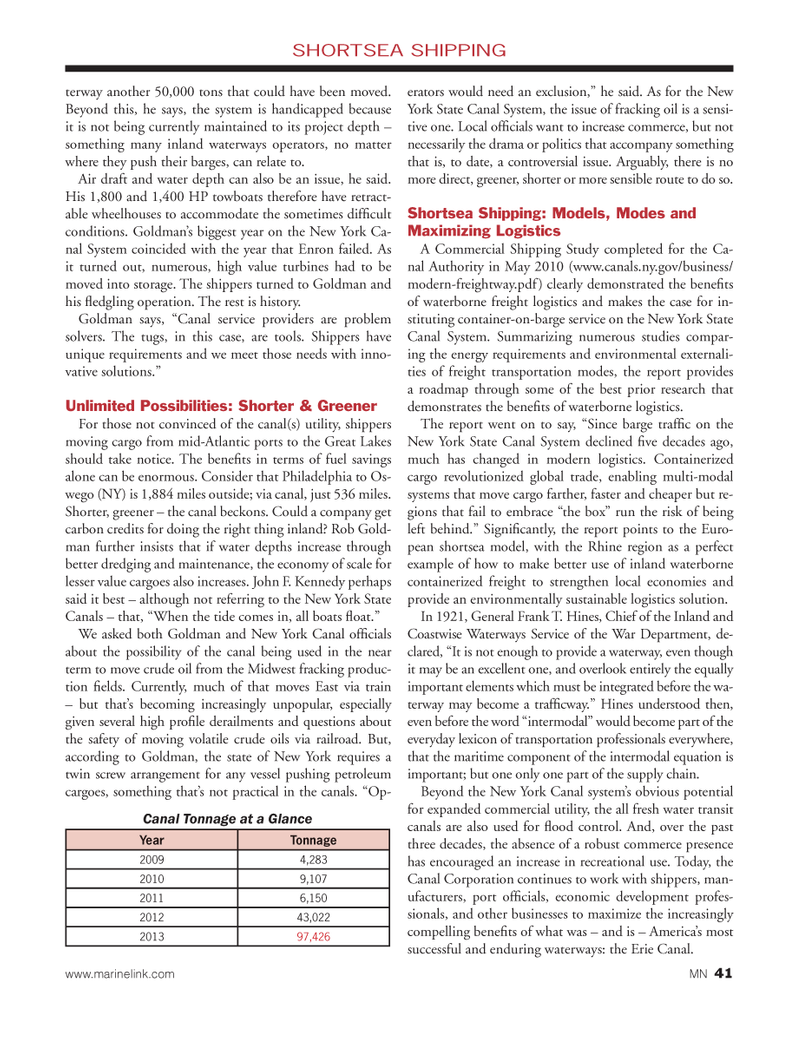
Page 41: of Marine News Magazine (April 2014)
Shipyard Report: Construction & Repair
Read this page in Pdf, Flash or Html5 edition of April 2014 Marine News Magazine
terway another 50,000 tons that could have been moved. Beyond this, he says, the system is handicapped because it is not being currently maintained to its project depth ? something many inland waterways operators, no matter where they push their barges, can relate to. Air draft and water depth can also be an issue, he said. His 1,800 and 1,400 HP towboats therefore have retract- able wheelhouses to accommodate the sometimes dif cult conditions. Goldman?s biggest year on the New York Ca- nal System coincided with the year that Enron failed. As it turned out, numerous, high value turbines had to be moved into storage. The shippers turned to Goldman and his edgling operation. The rest is history. Goldman says, ?Canal service providers are problem solvers. The tugs, in this case, are tools. Shippers have unique requirements and we meet those needs with inno- vative solutions.? Unlimited Possibilities: Shorter & Greener For those not convinced of the canal(s) utility, shippers moving cargo from mid-Atlantic ports to the Great Lakes should take notice. The bene ts in terms of fuel savings alone can be enormous. Consider that Philadelphia to Os- wego (NY) is 1,884 miles outside; via canal, just 536 miles. Shorter, greener ? the canal beckons. Could a company get carbon credits for doing the right thing inland? Rob Gold- man further insists that if water depths increase through better dredging and maintenance, the economy of scale for lesser value cargoes also increases. John F. Kennedy perhaps said it best ? although not referring to the New York State Canals ? that, ?When the tide comes in, all boats oat.?We asked both Goldman and New York Canal of cials about the possibility of the canal being used in the near term to move crude oil from the Midwest fracking produc- tion elds. Currently, much of that moves East via train ? but that?s becoming increasingly unpopular, especially given several high pro le derailments and questions about the safety of moving volatile crude oils via railroad. But, according to Goldman, the state of New York requires a twin screw arrangement for any vessel pushing petroleum cargoes, something that?s not practical in the canals. ?Op- erators would need an exclusion,? he said. As for the New York State Canal System, the issue of fracking oil is a sensi- tive one. Local of cials want to increase commerce, but not necessarily the drama or politics that accompany something that is, to date, a controversial issue. Arguably, there is no more direct, greener, shorter or more sensible route to do so. Shortsea Shipping: Models, Modes and Maximizing LogisticsA Commercial Shipping Study completed for the Ca- nal Authority in May 2010 (www.canals.ny.gov/business/ modern-freightway.pdf) clearly demonstrated the bene ts of waterborne freight logistics and makes the case for in- stituting container-on-barge service on the New York State Canal System. Summarizing numerous studies compar- ing the energy requirements and environmental externali- ties of freight transportation modes, the report provides a roadmap through some of the best prior research that demonstrates the bene ts of waterborne logistics. The report went on to say, ?Since barge traf c on the New York State Canal System declined ve decades ago, much has changed in modern logistics. Containerized cargo revolutionized global trade, enabling multi-modal systems that move cargo farther, faster and cheaper but re- gions that fail to embrace ?the box? run the risk of being left behind.? Signi cantly, the report points to the Euro- pean shortsea model, with the Rhine region as a perfect example of how to make better use of inland waterborne containerized freight to strengthen local economies and provide an environmentally sustainable logistics solution. In 1921, General Frank T. Hines, Chief of the Inland and Coastwise Waterways Service of the War Department, de- clared, ?It is not enough to provide a waterway, even though it may be an excellent one, and overlook entirely the equally important elements which must be integrated before the wa- terway may become a traf cway.? Hines understood then, even before the word ?intermodal? would become part of the everyday lexicon of transportation professionals everywhere, that the maritime component of the intermodal equation is important; but one only one part of the supply chain. Beyond the New York Canal system?s obvious potential for expanded commercial utility, the all fresh water transit canals are also used for ood control. And, over the past three decades, the absence of a robust commerce presence has encouraged an increase in recreational use. Today, the Canal Corporation continues to work with shippers, man- ufacturers, port of cials, economic development profes- sionals, and other businesses to maximize the increasingly compelling bene ts of what was ? and is ? America?s most successful and enduring waterways: the Erie Canal. SHORTSEA SHIPPINGYear Tonnage 20094,28320109,10720116,150201243,022201397,426Canal Tonnage at a Glance www.marinelink.com MN 41MN April14 Layout 32-49.indd 41MN April14 Layout 32-49.indd 413/20/2014 11:53:40 AM3/20/2014 11:53:40 AM

 40
40

 42
42
